Introducing your child to the joys of spending time in nature and engaging in exciting outdoor activities is undoubtedly one of the most fulfilling experiences as a parent. Kayaking can be a wonderful way to enjoy a day out on the water, soaking in the picturesque scenery, and getting some exercise in the process. If you’re considering taking your toddler along with you, navigating the unknown territory of kayaking with a little one can seem daunting. But fear not! With some thoughtful planning and preparation, you can ensure a safe, fun, and memorable kayaking adventure for both you and your toddler.
In this article, I will share with you my top tips for making your family kayaking excursion a success. We’ll discuss choosing the appropriate gear, locating the best spots for kayaking with young ones, and how to involve your toddler in this exciting experience while maintaining their safety. Plus, I’ll share some bonus tips on how to keep things fun and engaging for your curious little explorer throughout the journey. Let’s dive in and explore the world of kayaking with a toddler in tow!
Contents
Contents
Choose The Right Kayak And Gear For Your Toddler
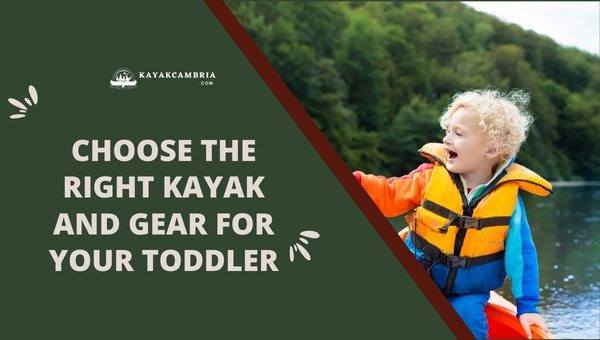
Selecting the appropriate kayak and gear for your child is crucial for ensuring their safety and comfort during your kayaking adventure. Begin by considering the following factors:
1. Stability And Space
Choose a stable and spacious kayak to accommodate both you and your toddler. Tandem kayaks with a wide base offer increased stability, making them an ideal choice for family outings.
2. Sit-on-Top Kayaks
Opt for a sit-on-top kayak, as these models offer greater convenience and safety for young children. Their open design allows for easier entry and exit and reduces hazards such as entrapment in the event of a capsize.
3. Child-sized PFD (Personal Flotation Device)
Invest in a high-quality, child-sized PFD (Personal Flotation Device) to ensure your toddler’s safety. Make sure it fits snugly, is appropriate for its weight, and is approved by the U.S. Coast Guard or other relevant authorities.
4. Kayak Seat Or Cushion
To increase comfort and encourage your toddler to remain seated during the trip, use a kayak seat or cushion designed for kids. These attachments provide additional support and stability, helping your child stay comfortable and safe throughout the journey.
By selecting the right gear, you can create an enjoyable and secure environment during your kayak outing with your toddler. Remember, the ultimate goal is to introduce them to the wonders of kayaking while prioritizing their safety and well-being.
Gradually Introduce Your Toddler To The Kayaking Experience
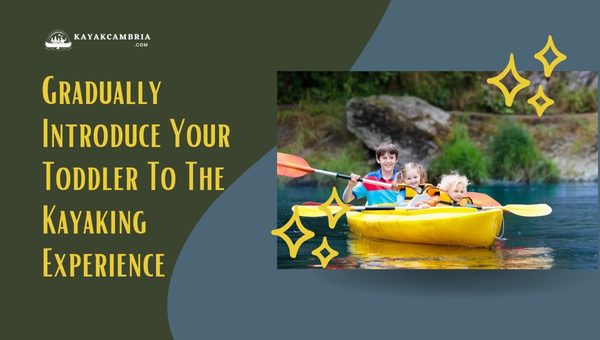
Introducing your toddler to kayaking in a gentle and gradual manner can make a significant difference in ensuring a positive experience. It’s important to create a sense of familiarity and comfort with the kayak, the gear, and the overall kayaking experience before embarking on an adventure together. Here are a few ways to gently acquaint your child with the world of kayaking:
Familiarize Them With The Kayak On Dry Land
Before hitting the water, start by acquainting your toddler with the kayak when it’s on dry land. Allow them to explore and sit inside the kayak, emphasizing that it’s a fun and exciting activity. Make sure they’re comfortable with the idea of being in the kayak before progressing to the next stage.
Practice Paddling Techniques Together
Once your toddler is comfortable sitting in the kayak, introduce them to the paddle. Show them how to hold the paddle correctly and make sure they understand its purpose. Demonstrate basic paddling techniques to them and encourage them to join you in practicing. Remember, you’re aiming to make this a fun and engaging experience for your little one.
Slowly Introduce Them To The Experience On Calm Waters
Now that they’re familiar with the kayak and the paddling techniques, it’s time to gradually expose them to the water. Start by allowing them to briefly sit in the kayak while it’s near the shore. Gently push the kayak into the water and paddle in a small circle close to the shore. As your child becomes more comfortable and confident, you can venture further out and paddle in larger circles. Once they’ve adapted to the sensation of being on the water and feel secure, you’re ready to begin your kayaking adventure together.
It’s essential to be patient throughout the process and never force your toddler to progress faster than they’re comfortable with. Keep in mind that it may take a few sessions for your child to fully adapt to the experience. Emphasize that kayaking is meant to be enjoyable for both of you and ensure they feel secure and supported at all times.
Opt For Safe And Suitable Kayaking Locations
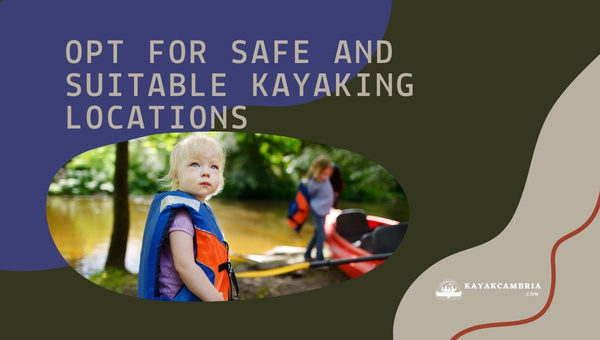
When planning a kayaking trip with your toddler, safety should always be your top priority. A great adventure begins with selecting the right location. Below are some key points to help you choose a safe and suitable kayaking spot for a fun-filled day with your little one:
Choose Calm And Shallow Waters
Opt for calm, shallow waters where unexpected waves and strong currents are less likely to pose a threat. This will make the kayaking experience more enjoyable and stress-free for both you and your toddler.
Investigate Local Family-Friendly Kayaking Spots
Do some research on local kayaking destinations that are renowned for their family-friendly environments. You can consult online forums or speak with experienced paddlers within your community for recommendations.
Check Weather Conditions And Plan Accordingly
Always check the weather forecast before heading out on the water with your toddler. Ideally, plan your trip on a day with mild temperatures and minimal wind. Avoid kayaking during rough weather conditions as this can make the experience significantly more challenging and potentially dangerous for both you and your child.
As you prepare for your kayaking adventure with your toddler, remember that selecting the right location is essential. By choosing a safe, family-friendly spot, you can focus on enjoying the experience and creating unforgettable memories together.
Prioritize Safety On The Water

As a parent, the safety of my toddler is always my top priority, and this holds true when it comes to our kayaking adventures. In order to ensure that our time on the water remains safe, enjoyable, and free from accidents, I always follow a few essential guidelines.
1. Review Water Safety Practices
Before setting out on our kayaking journey, I make sure to refresh my own knowledge of water safety practices. This includes knowing how to swim, basic rescue techniques, and understanding local rules and regulations. Ensuring that I am well-versed in these safety practices allows me to confidently navigate any potential challenges while on the water.
2. Be Ready To Communicate Basic Instructions
Clear communication is key when kayaking with a toddler. I spend time before our trip teaching my little one basic safety instructions, such as how to hold onto the kayak, what to do if they accidentally fall into the water, and how to signal for help if needed. This not only helps them feel more secure on the water but also enables me to focus on navigating the kayak safely.
3. Ensure Proper Sun Protection And Hydration
When spending time on the water, it’s crucial to protect both yourself and your toddler from the sun’s harmful rays. I always pack plenty of sunscreen, hats, and UV-protective clothing for both of us, and reapply sunscreen as needed throughout the day. Staying hydrated is equally important, so I make sure to bring along enough water for both of us and encourage my toddler to sip from their water bottle throughout our journey.
4. Keep A First Aid Kit And Emergency Supplies On Hand
Being prepared for unexpected situations is a must when kayaking with a toddler. In case of minor injuries or other emergencies, I pack a first aid kit, a whistle for signaling, a dry bag with a change of clothes, and a waterproof phone case to ensure that we always have access to help if needed.
By prioritizing safety on the water, our kayaking adventures become enjoyable and stress-free experiences for both me and my little one. By following these essential guidelines, you can confidently create unforgettable memories with your toddler while exploring the great outdoors.
Encourage Your Toddler To Participate And Have Fun
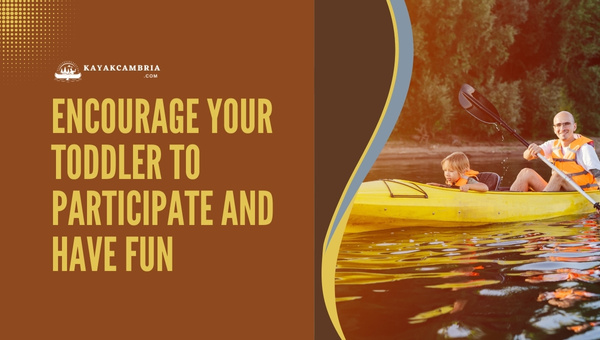
One of the keys to a successful kayaking trip with your toddler is to keep them engaged and entertained. By actively involving your child in the kayaking experience, they’re more likely to develop an appreciation for the activity and enjoy themselves on the water. Here are some ways you can encourage your toddler to participate and have fun on your kayaking adventure:
- Involve them in the paddling process: While it may not be wise to let them take full control of the paddles, you can teach your toddler some basic paddling techniques and let them try under your supervision. This not only keeps them engaged but also helps them feel a sense of accomplishment and pride.
- Teach them about the environment: Kayaking can be an educational experience as well as a fun one. Talk to your toddler about the water, surrounding plants, and any wildlife you may encounter on the trip. This not only holds their interest but also increases their understanding and appreciation of nature.
- Create games and challenges: Introduce some friendly competition and excitement into your kayaking trip by setting up mini-challenges or games for your toddler to complete. For example, you could have them spot and identify a certain number of birds or count how many paddle strokes it takes to reach a particular destination.
- Celebrate their achievements: Remember to praise your toddler for their efforts and accomplishments during the trip, and don’t forget to reward them with high-fives and hugs. Acknowledging their hard work not only boosts their self-esteem but also makes them more excited about participating in future kayaking adventures.
By devoting some time and attention to engaging your toddler in the kayaking experience, you’ll ensure that they’re not only entertained but also actively participating and having fun. This will not only create exciting memories for both of you but also lay the foundation for a lifelong love of the great outdoors.
Be Prepared For Unexpected Challenges
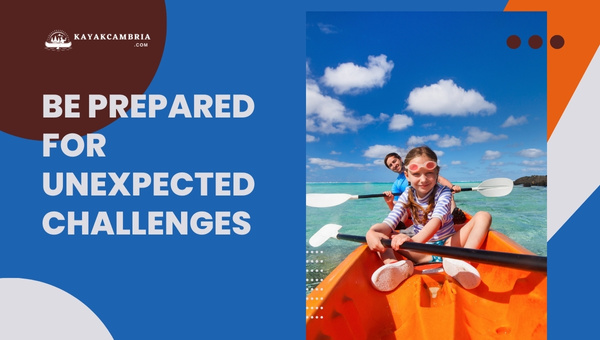
As a parent, I’ve learned that things don’t always go according to plan, especially when involving a young child. This is also true when it comes to kayaking with a toddler. To make the experience enjoyable, it’s essential to prepare for any unexpected hiccups along the way.
Stay Flexible With Your Plans
Remember, flexibility is the key component when it comes to outdoor adventures with your little one. It’s essential to let go of any rigid expectations you may have. Be prepared to adjust your kayaking route, change locations, or even cut your trip short if your toddler isn’t having a good time or weather conditions worsen.
Know Your Limits, And Your Toddler’s
Understanding both your toddler’s and your own limitations is crucial when kayaking. Toddlers can easily become overwhelmed or tired, while you, as the primary paddler, need to ensure that you don’t overexert yourself as well. Be mindful of when to take breaks for resting, eating, and allowing your toddler to stretch or explore on safe shorelines.
Pack Extra Clothes, Snacks, And Toys For Entertainment
It’s always a good idea to pack extra clothes, as toddlers are known for their ability to generate messes unexpectedly. Bring along plenty of snacks and water to keep them nourished and hydrated. Don’t forget to pack a few toys or activities, like coloring books or unique nature-watching tools, to keep them entertained during downtime.
Always remember that the primary goal of kayaking with your toddler is to have a safe and enjoyable experience. By being well-prepared for any unpredictable challenges, you’re setting the foundation for a successful and memorable adventure on the water.
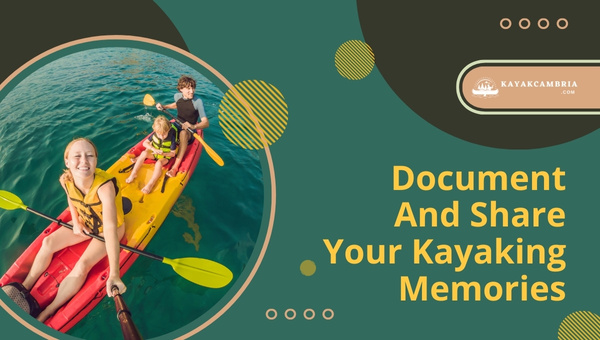
One of the most gratifying aspects of kayaking with your toddler is capturing the special moments you’ll create together. By documenting your adventure through photos and videos, you’ll have precious mementos you can look back on and cherish for years to come.
Bring a Waterproof Camera Or Action Camera
First, invest in a waterproof camera or action camera to ensure you can capture high-quality photos and videos during your kayaking trip. These cameras are specifically designed for rugged outdoor use and can withstand being submerged in water without any issues. Remember to pack extra batteries or a portable charger to keep your camera running throughout your excursion.
Capture Candid Moments
While you’ll undoubtedly snap some posed shots of your toddler in the kayak, also focus on capturing candid moments. These unplanned photos can capture their genuine reactions, laughter, and wonder as they experience the joys of kayaking for the first time. You might even consider bringing a small tripod or mounting your action camera onto the kayak to help record your journey.
Once you’ve documented your kayaking experience, don’t hesitate to share these moments with friends and family on social media (if you’re comfortable doing so!). Sharing your adventures can showcase the value of spending time outdoors with your children and might inspire other families to give kayaking a try with their little ones.
Finally, involve your toddler in the process of reliving and sharing the kayaking adventure. Encourage them to tell their friends, grandparents, or siblings about their experience, highlighting interesting or exciting moments. This helps to reinforce the positive memories of the trip and embed the love of kayaking into their lifelong repertoire of activities.
Documenting and sharing your kayaking memories is a wonderful way to preserve the special moments you create with your toddler. And who knows your shared experiences might just inspire the next generation of paddle adventure enthusiasts!
Tips To Keep It Fun For Toddlers
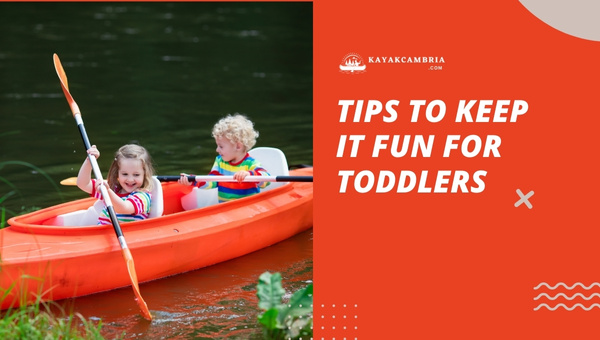
Kayaking with your toddler should be an activity filled with joy and excitement. To make sure everyone has a great time, try out some of the following tips for keeping the adventure fun:
Bring Some Of Your Toddler’s Favorite Toys Or Games
One way to keep your little one engaged and happy on the water is to bring along some of their favorite toys or games. For instance, waterproof toys, puzzle pieces, or even a small collection of action figures can keep them entertained during calmer periods or any downtime due to weather or rest stops.
Sing Songs
Music can be a great way to keep everyone entertained, especially for toddlers. You can sing some of your child’s favorite tunes or make up your own songs about nature, animals, or even about kayaking itself. The important thing is to make it enjoyable and engaging enough to keep your toddler’s attention.
Play “I Spy” And Other Traditional Kids’ Games
Kayaking can offer plenty of opportunities for playing “I Spy” or other games that require observation and a little imagination. Involve your toddler by asking them to point out interesting sights along the way, whether it’s a colorful bird, a unique rock formation, or a boat passing by. This will encourage their curiosity and make the trip even more exciting.
Plan Ahead For Snack Breaks
Paddling can be tiring, especially for little ones. Make sure you bring plenty of toddler-friendly snacks and healthy treats. Plan regular breaks to stop and enjoy your snacks, along with the beautiful scenery around you. This will also give your child a chance to regain their energy and enthusiasm for the rest of the trip.
Be Flexible With Your Time And Expectations
Above all, remember that this kayaking trip is an adventure for you and your toddler to enjoy together. Schedule plenty of time for breaks, exploration, and even a little quiet downtime if needed. Adjust your expectations accordingly, and don’t stress if you don’t cover as much ground as initially planned. The key is to maintain a sense of fun, wonder, and excitement during your time on the water.
By incorporating these tips, your kayaking adventure with your toddler is sure to be filled with laughter, discovery, and a strong bond with nature.
When Can A Child Paddle Their Own Kayak?
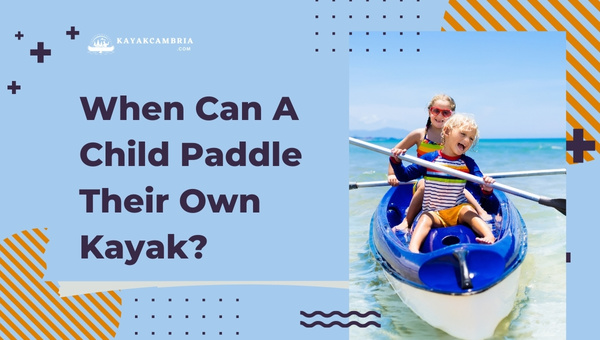
As a parent, it’s natural to wonder when your child can transition from sharing your kayak to paddling on their own. However, there isn’t a one-size-fits-all answer to this question, as each child is unique and develops at their own pace.
When considering whether your child is ready to paddle their own kayak, keep the following factors in mind:
- Age: Generally speaking, children around the age of 10 or older might have the physical strength, coordination, and focus needed to paddle their own kayak effectively. However, some children may be ready earlier, while others may need more time.
- Experience: Prior kayaking experience is important. A child who’s been kayaking with an adult for a while may be more prepared to handle a solo kayak than one who is entirely new to the sport.
- Confidence: Taking into account your child’s confidence in their abilities is crucial. If they’re comfortable and eager to paddle their own kayak, this can indicate readiness.
- Independence: A child who understands and follows safety rules and can make smart decisions independently is more likely to be ready for their own kayak.
It’s important to remember that even when your child meets these criteria, supervision, and guidance are still essential, especially as they begin their solo kayaking journey. You can ease this transition by:
- Providing guidance in calm conditions: Start by introducing your child to solo kayaking in calm, shallow waters close to shore and under your watchful eye.
- Choosing the right kayak for their size and skill level: Opt for a stable, child-sized kayak designed for beginners.
- Practicing essential skills: Spend time working on paddling techniques, self-rescue methods, and water safety guidelines before allowing your child to kayak alone.
Finally, always trust your instincts as a parent. If you feel that your child isn’t quite ready to tackle kayaking on their own, continue to involve them in shared kayak outings until they show signs of readiness. Remember, the goal is to foster a love for the outdoors and create positive experiences that will last a lifetime, so there’s no need to rush the process.
Essential Things To Pack Before Kayaking With Kids in 2024
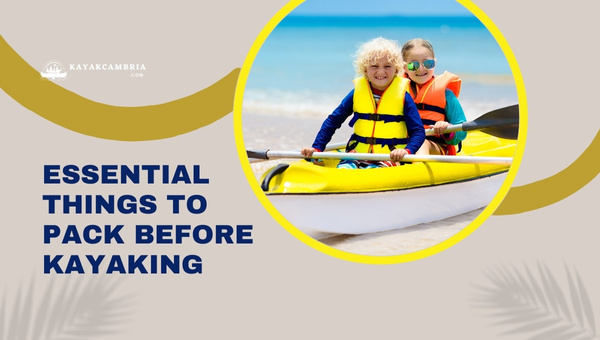
When planning a kayaking trip with your toddler, making sure you have all the necessary gear and essentials can ensure a safe and enjoyable experience for both of you. Here’s a handy list of items to pack when kayaking with your little one:
- Personal Flotation Devices (PFDs): Ensure you have appropriately sized PFDs for you and your toddler that are Coast Guard-approved and comfortable to wear.
- Paddles: Choose lightweight paddles for you and a kid-sized paddle if your toddler wants to help.
- Sun protection: Include sunscreen with a high SPF, sunglasses, wide-brimmed hats, and protective clothing to shield both you and your toddler from harmful UV rays.
- Hydration: Bring along plenty of water to stay properly hydrated during the entire trip. Sippy cups with spill-proof lids are great for toddlers.
- Snacks: Pack healthy, non-perishable snacks such as granola bars, fruit, and trail mix to keep hunger at bay.
- Extra clothes: Bring along a change of clothes for you and your toddler, especially if the weather conditions are unpredictable or if your child might get cold or wet during the adventure.
- Entertainment: Bring small toys or games to keep your toddler engaged and entertained during breaks or while on the water.
- First aid kit: A well-stocked first aid kit should include band-aids, antiseptic wipes, tweezers, pain relievers, insect repellent, and any necessary medications for you and your toddler.
- Safety whistle: Carry a safety whistle to signal for help in case of emergencies.
- Dry bags or waterproof containers: Use these to keep electronics, cameras, and other valuables safe and dry while on the water.
- Navigation tools: Bring along a map, compass, or GPS to ensure you’re always on track.
- Backup plan: In case of bad weather, equipment failure, or other emergencies, have a backup plan in place to ensure your safety and that of your toddler.
By taking the time to carefully pack these essential items, your kayaking trip with your toddler will not only be a fun and memorable experience but also a safe and well-prepared one.
Benefits of Kayaking for Toddlers
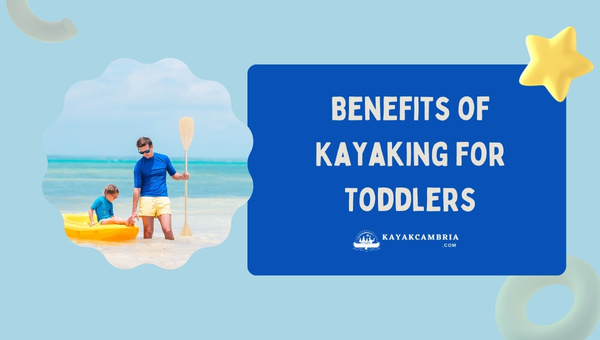
Kayaking offers a plethora of benefits that can help contribute to the physical, emotional, and cognitive development of children, making it much more than just a fun activity. Here are some reasons why kayaking can be incredibly advantageous for kids:
- Physical Exercise: Kayaking is an excellent low-impact workout that promotes upper body strength, core stability, balance, and overall endurance. It’s a great way to encourage kids to stay active and develop healthy habits while enjoying the outdoors.
- Boosts Confidence and Self-Esteem: Learning to paddle a kayak independently instills a sense of accomplishment and pride in kids. As they improve their skills and become more comfortable on the water, their self-confidence and self-esteem will naturally grow.
- Mental Relaxation and Stress Relief: Being surrounded by nature, enjoying the serene movement of the water, and focusing on paddling can provide kids with a calming and therapeutic experience. Kayaking allows children to unwind and alleviate stress while immersed in the tranquility of their surroundings.
- Cultivates Patience and Perseverance: Mastering kayaking techniques requires determination and practice. Children who persistently practice their kayaking skills will develop patience and resilience, which can be applied to other aspects of their lives.
- Enhances Social Skills and Teamwork: Kayaking is often a group activity, and kids have the opportunity to interact with others and work together to achieve common goals. This fosters camaraderie, teamwork, and improved communication skills among kids.
- Connection with Nature: Kayaking grants children the unique opportunity to observe and learn about various ecosystems, wildlife, and environmental aspects of the natural world. This nurtures a sense of curiosity and respect for the environment, motivating them to become future guardians of the planet.
- Improves Cognitive Skills and Problem Solving: Navigating the water while kayaking can be challenging and requires children to think on their feet. They’ll quickly learn how to adapt to different situations, make quick decisions, and solve problems, all while enhancing their spatial awareness and hand-eye coordination.
Kayaking is an enriching and enjoyable activity that offers a wealth of physical, emotional, cognitive, and social benefits for children. By introducing your kids to this incredible pastime, you’re not only creating fantastic memories together but also helping them grow into well-rounded individuals.
What Not To Do When Kayaking With Toddlers?
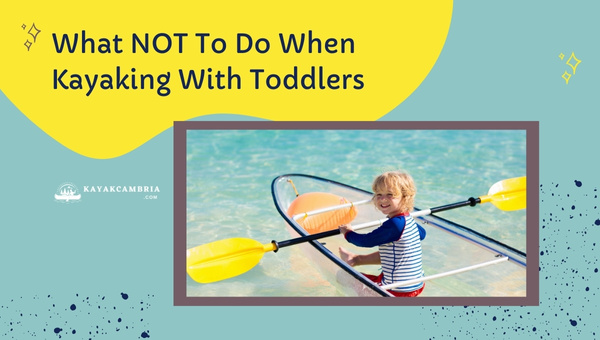
Taking your toddler or young child along on a kayaking excursion can be great fun for both of you, but it’s essential to know what to avoid in order to ensure a safe and enjoyable adventure. Here are some key things you should NOT do when kayaking with kids:
- Never leave children unattended: Continuously monitor your child while on or near the water, and always keep them within a safe distance. They should never be left unsupervised on the kayak or the shoreline.
- Don’t choose challenging environments: Stick to calm, shallow water areas when kayaking with little ones. Avoid places with strong currents, tides, or waves that can easily capsize your vessel or cause distress for your child.
- Avoid overcrowding the kayak: Ensure there is enough space on the kayak for both you and your child, plus any necessary gear. An overcrowded kayak can be unstable and increase the risk of capsizing.
- Don’t forget the life jackets: A properly fitted PFD (Personal Flotation Device) is an absolute must for your child, as well as for yourself. Never take your child on the water without suitable flotation devices.
- Don’t push your child’s limits: If your toddler is showing signs of discomfort or fear, be prepared to change your plans or end your adventure. Pushing a child’s limits in an unsafe environment can lead to accidents or negative experiences.
- Don’t neglect proper sun protection and hydration: Ensure both you and your child are well protected from the sun’s harmful rays with sunscreen, hats, and sunglasses, and bring plenty of water to stay hydrated during your trip.
- Do not rely solely on your child’s swimming skills: While it’s beneficial for your child to know how to swim, do not rely on this skill as the sole safety measure while kayaking. Equip your child with a PFD, and be ready to provide assistance if needed.
When taking your little one on a kayaking adventure, safety should always be your number one priority. By being aware of the potential hazards and understanding what to avoid, you can help ensure a successful kayaking experience that will create lasting memories for you and your child.
Frequently Asked Questions
1. What age can a child start kayaking with an adult?
It depends on the child’s physical ability and comfort level around water, but generally, toddlers between 2-4 years old can start kayaking with an adult in a tandem kayak. The key is to ensure your child fits safely into a child-sized PFD and is ready to follow basic safety instructions.
2. How can I make sure my toddler stays safe while kayaking?
Some essential safety tips include choosing the right kayak and gear, staying in calm and shallow waters, ensuring proper sun protection, and keeping a first aid kit on hand. Always make sure your toddler is wearing a properly fitted PFD and keep an eye on them at all times.
3. How do I keep my child entertained during the kayaking trip?
Encourage your toddler to participate in paddling, explore the surrounding environment, and watch for wildlife. Pack their favorite snacks, toys, or comfort items for breaks, and be prepared to sing songs or play games if needed to keep them engaged.
4. What if my toddler becomes scared while on the water?
Listen to your child’s concerns and offer reassurance. If necessary, consider paddling closer to the shore or stopping the kayak to provide a sense of security. Remember to stay calm and flexible, as your own confidence will help your toddler feel more at ease.
5. How can I teach my toddler to paddle a kayak?
Start by demonstrating paddling techniques on dry land and allow your child to practice with a small paddle. As they become more confident, gradually introduce them to these techniques on the water, always with adult supervision.
6. Are there any special kayaking techniques for parents with toddlers?
The main techniques to keep in mind are maintaining stability and offering clear communication. Choose a stable kayak, ensure your toddler is seated comfortably, and paddle gently to minimize the risk of capsizing. Be prepared to give your child simple instructions to help them follow along and participate safely.
7. Can I take a baby on a kayak?
It is not recommended to bring a baby on a kayak, as their motor skills and ability to follow safety instructions are not yet developed. It’s best to wait until your child is a toddler and can comfortably wear a child-sized PFD before introducing them to kayaking.
8. What essential items should I pack for a kayaking trip with my toddler?
Some important items to pack for a kayaking adventure with your toddler include:
1. Child-sized PFD
2. Sun protection (sunscreen, hats, sunglasses)
3. Extra clothes
4. Snacks and water
5. Toys or comfort items
6. First aid kit and emergency supplies
7. Waterproof bags to keep items dry
Conclusion
Kayaking with your toddler is an incredible opportunity to bond with your little one and introduce them to the joys of outdoor adventure. By carefully selecting the right equipment, gradually familiarizing them with the experience, focusing on safety, and encouraging their participation, you’ll create a fun and exciting excursion for both of you.
Remember to be prepared for unexpected challenges and to allow for flexibility in your plans so that your kayaking trip can adapt to your toddler’s unique needs and interests. Capture those precious moments, and don’t forget to share your memories with friends and family. With these tips and strategies, you’re well on your way to creating lasting and cherished memories as you paddle along on your kayaking adventure with your toddler.

